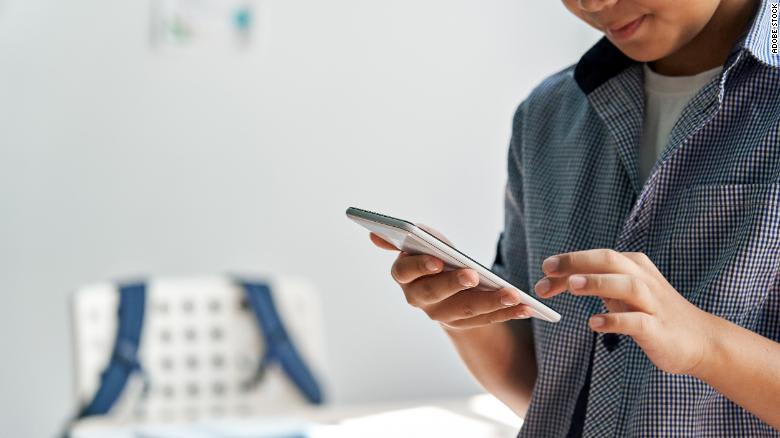دبي، الإمارات العربية المتحدة (CNN) – أظهرت دراسة نُشرت الإثنين في المجلة العلمية "JAMA Pediatrics"، أنّه سُجّل ارتفاعًا بمعدّل الوقت الذي يقضيه الأطفال أمام الشاشات، منذ بدء الجائحة، ولا يبدو أنّ الأمور ستعود إلى ما كانت عليه سابقًا، في المدى المنظور.
وكشفت الدراسة أنّ المراهقين يمضون قرابة ثماني ساعات يوميًّا أمام الشاشة، أي ضعف الوقت المقدّر بأربع ساعات تقريبًا، قبل الجائحة. ولا يشمل هذا الوقت الدروس الافتراضية، بل الأنشطة الترفيهية مثل مشاهدة التلفزيون والألعاب الافتراضية، ومنصات التواصل الاجتماعي، إلى كتابة الرسائل النصية وإجراء محادثات تستخدم تقنية الفيديو، بالإضافة إلى تصفّح المواقع الإلكترونية.
ولفت المشرف على الدراسة الدكتور جايسن ناغاتا، الأستاذ المساعد في طب الأطفال في جامعة كاليفورنيا في سان فرانسيسكو الأمريكية، إلى أنّ المراهقين الذين أمضوا عدد ساعات أكبر أمام الشاشة يعانون من مصاعب أخرى في حياتهم.
ما الرابط بين وقت الشاشة والصحة العقلية؟
وقال ناغاتا إنّ "الجلوس لوقت طويل أمام الشاشة مرتبط بتسجيل تراجع في الصحة العقلية والإجهاد الكبير بين المراهقين".
وشملت الدراسة 5412 مراهقًا تتراوح أعمارهم بين 10 و14 عامًا، سُئلوا عن عادات وقت الشاشة التي اكتسبوها. وكشف الباحثون أن الأطفال أمضوا معدّل 7.7 ساعات في اليوم أمام الشاشة، أي بزيادة 3.8 ساعات يوميًا.
وطُلب من المشاركين في البحث تصنيف صحتهم العقلية من "الأسوأ" إلى "الأفضل، بالمقارنة مع الأسبوع الماضي. كما طُرحت عليهم أربعة أسئلة حول شعورهم بالإجهاد، على سبيل المثال: "في الشهر الماضي، كم مرة شعرت بأنّ الصعوبات تتكاثر على نحو لا يمكنك تخطيها"؟
وقالت الدكتورة جيني راديسكي، التي لم تشارك في الدراسة، وهي طبيبة النمو السلوكي لدى الأطفال وأستاذة مساعدة في طب الأطفال في مستشفى ميتشيغان الطبي "سي. اس. موت للأطفال" في آن أربور الأمريكية، إنّ الرابط بين الإستخدام الطويل للشاشة والإجهاد كان مفاجئًا.
وأشارت إلى أنّ "غالبية العائلات اعتقدوا أنّ تواصل أطفالهم مع الأصدقاء من خلال الألعاب الإفتراضية، ووسائط التواصل الاجتماعي، أو مشاهدة الأفلام، سيخفّف من الإجهاد خلال الجائحة".
ورأت راديسكي أنّ العلاقة السلبية هذه قد يكون مردّها إلى "النزعة للبحث عن الأخبار السلبية" لمدّة طويلة من الزمن، على وسائل التواصل الاجتماعي. وأضافت أنّ ساعات الشاشة الطويلة تقلّل من الوقت المتبقي للمشاركة في أنشطة "تساعد على بناء القدرة على التكيّف خلال الأوقات العصيبة، بينها النوم، والوعي التام، والأنشطة البدنية".
وفي المقابل، يتمتّع المشاركون الذين أمضوا وقتًا أقل أمام الشاشة بعلاقات أمتن بالعائلة والأصدقاء، وبقدرات سلوكيّة أقوى على التكيّف.
تحديد وقت الشاشة
ويتوقّع ناغاتا ألا يتراجع الوقت الطويل الذي يقضيه المراهقون أمام الشاشة قريبًا، بالتوازي مع انحسار الجائحة.
وأشار إلى أنه رغم البدء بالمرحلة الانتقالية للعودة إلى متابعة الأنشطة الأكاديمية حضوريًا، والمشاركة الشخصية في الأنشطة الاجتماعية، لكن ازدياد الخيارات الإفتراضية المتاحة، تشي بأنّ "معدّل استخدام الشاشة سيبقى مرتفعًا أكثر ممّا كان عليه قبل الجائحة".
وأوصى ناغاتا الأهل بتحديد وقت الشاشة لأطفالهم، وتشجيعهم على تجنّب التعرّض لها قبل وقت النوم.
نموذج السلوك الخالي من الأجهزة
وقال المدير الأول للأبحاث في جمعية "كامن سانس ميديا" مايكل روب، غير المشارك في البحث، إنّ "على الأهل أن يكونوا قدوة لأطفالهم من خلال الابتعاد عن أجهزتهم الالكترونية خلال الوقت المخصّص للعائلة ولتناول الوجبات، وألا تعيق تفاعلهم مع أطفالهم على نحو مستمر".
ولفتت راديسكي إلى أنّ العديد من الأفلام والألعاب الإلكترونية يتمتّع تصميمها بخصائص تجذب المستخدم وتجعله يعود إليها يوميًا، وذلك إن من خلال التشغيل التلقائي، أو عبر إرسال إشعارات. لذا يتوجّب على الأهل اللعب مع أطفالهم لتحديد هذه الخصائص وإلغائها.
وأوصى روب الأهل بأنه بدلًا من تعداد الوقت الذي يقضيه طفلهم أمام الشاشات، عليهم تشجيعه على إتمام المهام المطلوبة منه، مثل الواجبات المنزلية والأعمال المتوجبة عليه داخل المنزل.



